The post Why You Should Add More Sardines to Your Diet appeared first on Like Ah Trini.
]]>They may be small, but they pack a big dose of nutrition and have been a part of our Trinbagonian and Caribbean culinary tradition for generations. Sardines are available fresh, canned, or frozen, making them a convenient and affordable option for adding healthy and delicious seafood to your meals.
In this post, we’ll explore the health benefits of sardines and how you can incorporate them into your menu.
What Are Sardines?
Sardines usually refer to small, silver, oily fish in the herring family. The name is believed to have originated from the island of Sardinia, one of the regions of Italy where these fish were found in abundance.
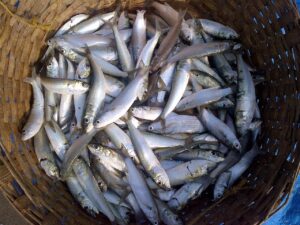
They not only serve as a delicious culinary delight but also have a practical use during times of disasters to provide relief to victims of devastation. You can stock up on sardines as part of your disaster preparedness plan, as the canned version has a long shelf life, is portable, and can be eaten straight from the can, providing a good source of nutrition when needed.
Benefits of Sardines for Your Health
Rich in Omega-3 Fatty Acids
Sardines are a wonderful source of omega-3 fatty acids, which have been shown to protect the heart, reduce inflammation, lower LDL (bad) cholesterol, and boost brain function. The healthy fats they contain also support mental clarity and health, which may have positive effects on mental well-being, fighting against depression and anxiety. Omega-3 fatty acids have been linked to potential anti-cancer benefits.
High in Protein
Protein is one of the macronutrients that we need in our diet as it is crucial for building and repairing tissues. Sardines are a powerhouse of high-quality protein and they contain all nine essential amino acids that our bodies need.
Contributes to the Health of the Bones
Calcium and vitamin D are both crucial for building and maintaining strong bones and teeth. Sardines are an excellent source of these essential nutrients. As we get older, it becomes increasingly important to take care of our bones and reduce the risk of osteoporosis, and sardines can play a vital role in supporting our bone health.
Rich in Vitamins and Minerals
Sardines contain essential vitamins and minerals such as vitamin D, B12, calcium, magnesium, iron, potassium, zinc, and the amino acids taurine and arginine.
May Help with Weight Loss
Sardines are relatively low in calories. One can of sardines in spring water contains 130 calories. Also, because they are high in protein and omega-3, they can improve metabolism and contribute to satiety, keeping you feeling fuller longer. This can help with unnecessary snacking and overeating.
Sardines Can be Part of Your Beauty Arsenal
Sardines can do wonders to improve your skin, hair, and nails.
Skin
Don’t worry, this has nothing to do with making a sardine mask and smearing it on your face.
Sardines are super beneficial for the skin due to their nutritional profile. The anti-inflammatory properties of the omega-3 fatty acids help to improve the appearance of the skin, while vitamin D and calcium promote skin cell regeneration.
Also being a good source of protein, sardines contribute essential amino acids vital to collagen production, which maintains elasticity and firmness.
Dermatologist Dr. Nicholas Perricone, the author of Ageless Face, Ageless Mind, believes in the power of anti-inflammatory foods and holds this fish in high esteem. He often emphasizes its role in obtaining smooth, supple, younger-looking skin.
Hair
Sardines are rich in Vitamin D3 and calcium, both of which promote hair growth and have even been shown to regrow hair in the case of alopecia.
According to Medical Hair Restoration:
“Adequate levels of vitamin D3 are essential for healthy hair growth, as it supports the growth and maintenance of hair follicles. One of the primary ways in which vitamin D3 promotes healthy hair growth is by improving the absorption of calcium. Calcium is an essential mineral required for the growth and maintenance of healthy hair.”
Nails
Sardines also contain an impressive amount of biotin, also called Vitamin B7. Not only is biotin good for the hair, but it also promotes healthy nail growth by strengthening the nails.
It Can Protect Against Type 2 Diabetes
A study published in the Clinical Nutrition, Journal in 2021 showed that consumption of sardines has a protective effect against type 2 diabetes.
Diana Díaz Rizzolo, who has a PhD in Biomedicine and is a university lecturer, stresses that sardines should be recommended by doctors, especially to patients over the age of 65 to prevent the onset of type 2 diabetes.
You can read her review of the benefits of sardine consumption here: Prevention of Type 2 Diabetes Through Sardines Consumption: An Integrative Review.
It is Sustainable
Sustainability is vital for our oceans, and sardines are more sustainable than many other types of seafood. These fish grow rapidly and can repopulate quickly, and fishing methods used to catch them do not cause significant damage to marine ecosystems.
Safer Choice of Fish
Due to their lower position on the food chain and shorter lifespan, sardines are considered a safer choice with lower levels of mercury and pollutants.
Inexpensive and Versatile
Compared to other oily fish like salmon, sardines are a more economical option, making them ideal for families on a budget. It is a nutrient-packed seafood that is easily accessible and can be added to a variety of recipes.
In our household growing up, I only knew sardines were prepared one way – we just called it ‘sardine’, now I know it as ‘Sardine Choka’. I remember it being a supper favourite with either roast bake or Crix with a cup of milky bush tea – that was a treat we all looked forward to.
Note: As with any dietary change, individuals with allergies or health conditions should consult their healthcare provider before adding new foods to their diet.

Sardine Choka Recipe
Ingredients:
- 2 cans of sardines, drained
- 1 small onion, finely chopped
- 2-3 cloves of garlic, minced
- 1 medium-sized tomato, diced
- 1 Scotch Bonnet pepper, finely chopped (optional)
- 1 pimento pepper, finely chopped
- 2 tablespoons oil
- Salt and black pepper to taste
- Fresh Shadon Beni leaves (culantro), finely chopped
- Lime or lemon juice
Instructions:
- Heat the oil in a frying pan over medium heat. Add the chopped onions and sauté until they become translucent.
- Stir in the minced garlic, pimento pepper, and hot pepper (if using) and cook for another minute or until the garlic becomes aromatic.
- Add the diced tomatoes to the pan and cook until they soften and release their juices.
- Now, it’s time to add the star of the show – the sardines! Break the sardines into smaller pieces with a fork as you add them to the pan.
- Gently stir and cook the fish with the onion, garlic, pimento and tomato mixture for a few minutes until everything is well combined and heated through.
- Season with salt and black pepper to taste. Remember that the sardines might already have some salt from the canning process, so adjust accordingly.
- Once everything is cooked and seasoned to perfection, remove the pan from the heat.
- Serve the choka on a platter or in individual bowls, garnishing with chopped shadon beni for some extra freshness and flavour. This can be eaten with crackers, warm roti, or steamed rice. Don’t forget to squeeze some lime or lemon juice over the choka just before eating – the tangy kick enhances the flavours!
How to Include Sardines in Your Family Menu
There are many ways to incorporate sardines into your menu. Other than the Sardine Choka recipe in this post, there are other creative ways to enjoy sardines. They can be included in recipes for:
- Fish Broth
- Salads
- Vegetable Stir Fries
- Tacos
- Pizza
- Pasta
- Fish Stews
- Sandwiches
Sardines are undoubtedly a nutritional powerhouse that brings both health benefits and a taste to our Caribbean dishes. With their omega-3 content, protein, and abundance of essential nutrients, sardines are an excellent addition to any diet.
Let us know in the comments, what are your favourite ways to prepare sardines?
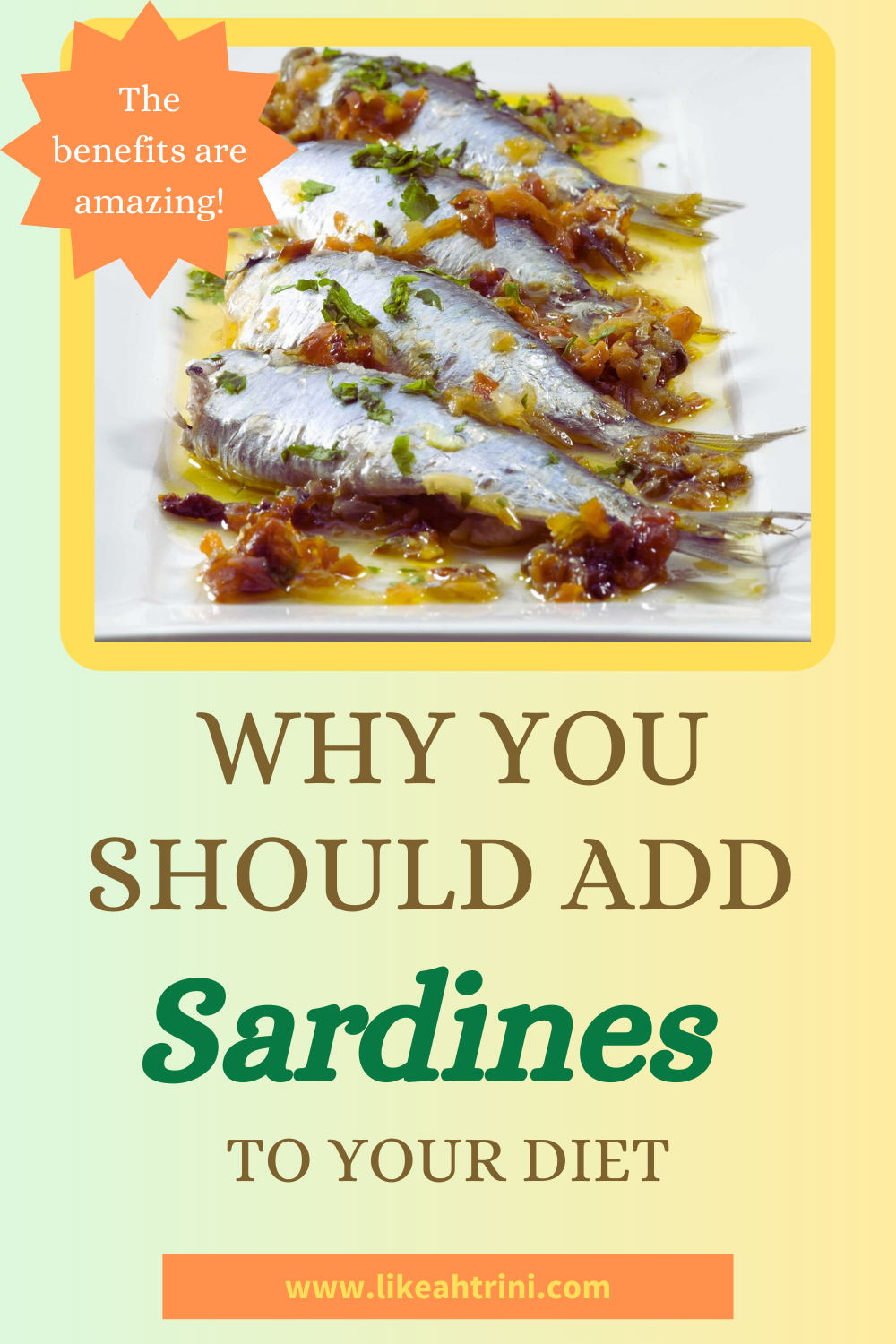
The post Why You Should Add More Sardines to Your Diet appeared first on Like Ah Trini.
]]>The post Homemade Sauerkraut – Fermented Cabbage appeared first on Like Ah Trini.
]]>The word ‘sauerkraut’ itself is a German word that literally translates to ‘sour cabbage’, however, it is believed that it originated with the Chinese who started fermenting cabbage in the 7th century BC.
So esteemed was this early ‘superfood’ known for being rich in vitamin C, that in 1768 Captain James Cook, a British navigator and explorer made certain to take it with him in abundance on his long sea voyage to prevent scurvy among his men.
Before the invention of refrigeration, fermenting fresh foods was a valuable form of preservation to extend shelf-life and reduce food spoilage and wastage. This has been practised for thousands of years among many cultures throughout the world. Today, this has given us foods such as:
- Kimchi from Korea
- Lassi from India (Dahee)
- Miso and Natto from Japan
- Garri from Africa
- Tempeh from Indonesia


In Trinidad and Tobago, other than yoghurt, dahee, which was brought to Trinidad and Tobago by East Indian indentured labourers, is a popular fermented food. There has also been a recent increase in local producers making probiotic drinks such as kombucha and kefir.
As far as I know, Haitian fermented Pikliz is probably the closest Caribbean dish to sauerkraut. It is similar to a blend of pepper sauce and fermented cabbage.
Why Eat Fermented Foods?
Hippocrates, the father of modern medicine is quoted as saying, “all diseases begin in the gut” and many studies are indeed proving that there is a connection between the risk of disease and gut health.
Beneficial bacteria in the gut or intestinal tract contribute greatly to our physical and mental health. They help keep ‘bad’ bacteria in check which have been shown to contribute to anxiety, depression, and overeating leading to obesity, among many other ails.
In addition, our lifestyles have changed so much from natural origins with the consumption of excess sugar and processed food, that the microbiome in the gut is imbalanced in many individuals. Adding fermented foods to our diets can introduce beneficial microbes into the intestinal tract to help keep harmful bacteria in check.
What Is Lacto-Fermentation?
Lacto-fermentation, the process used to make sauerkraut, is the process by which lactic acid bacteria, break down sugar into lactic acid and carbon dioxide.
To make sauerkraut, cabbage is shredded and between 2% to 3% salt (by weight) is added. The salt is squeezed and massaged into the cabbage to allow the cell walls to break for the cabbage to release its natural water. Also by osmosis, the water is drawn out of the cabbage to create a brine.
The salt content of the brine kills harmful microorganisms, while the lactic acid bacteria (mainly lactobacillus species) survive. The lactobacilli, which naturally live on the cabbage leaves, then convert the natural sugars in the cabbage into lactic acid and carbon dioxide. The salt hardens the pectins in the cabbage, giving it its crunchy texture while the acidity preserves it and gives it its tangy flavour. During fermentation, the sauerkraut becomes bubbly as carbon dioxide is created, but this usually stops when the acidity or pH of the sauerkraut reaches 3.5 or less; then the lactobacilli growth is inhibited and fermentation stops.
There are many benefits of sauerkraut;
- It is high in vitamin C, antioxidants and minerals
- It is packed with living probiotics that contribute to healthy digestive flora
- It is high in vitamin K2 that promotes healthy arteries
- It may contribute to weight loss due to being high in fibre and low in calories (27 calories per cup)
- It improves digestion due to a variety of enzymes it contains
- It improves immunity
- There is increased nutrient availability
Personally, I love the crunchy tangy flavour of sauerkraut in sandwiches, salads, burgers, as a side dish with foods like pelau, or sometimes I would just eat a spoonful when I’m feeling for ‘something salt to pass in mih mouth‘.
Typically, sauerkraut is just two ingredients – cabbage and salt – but you know the Trinbagonian in me will want to ‘Trinify’ the recipe. So I add seasonings to my sauerkraut. In the recipe below, I added, shadon beni (culantro), garlic and pimento peppers. This is totally optional as well as you can add your own spices according to your taste.
Salt
As mentioned previously, salt helps to create a favourable environment for the lactic acid bacteria and also prevents the growth of harmful microorganisms. The ideal amount of salt used for fermentation is 2.25% to 2.5% salt by weight or 1 1/2 to 2 teaspoons per pound of cabbage.
Avoid using salts high in fluoride and iodine as they may inhibit the fermentation process. Opt for unrefined high mineral salts such as pure sea salt or Himalayan pink salt. Also, avoid coarse salt, a finer grade will dissolve better in the brine.
This is the Himalayan pink salt that I used.

Choosing A Cabbage For Sauerkraut
When shopping for cabbage, choose a head that is firm with fresh, crisp leaves, not old or wilted. Good quality cabbage will yield good quality sauerkraut. It is best to seek out one that is free of pesticides or other chemicals.
For this recipe, I used three pounds of green cabbage (this was the weight after chopping and removing the stem).
Equipment
- Cutting board
- Knife
- Kitchen Scale
- Large Mason or Glass Jar
- Fermentation weights ( or marbles, stones)
- Small container (for leaves)
- Large container to mix cabbage
Ingredients
- 3 lbs of cabbage
- 6 tsp salt (sea or pink)
- 5 large shadon beni leaves (culantro)
- 1 head of garlic
- 4 pimento peppers
Directions to Make Sauerkraut
Always start with clean utensils and surfaces.

Remove the outer leaves of the cabbage. Rinse them thoroughly under running water and set them aside to drain for use later on.
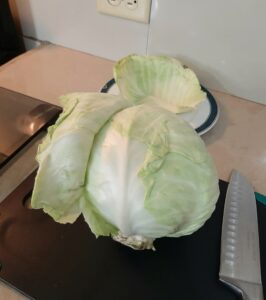
Prepare the cabbage by slicing or shredding. Discard the core (or put it in your next batch of bone broth.)
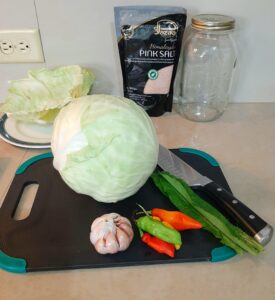
Chop or mince the pimentoes and chadon beni. I finely grated the garlic but it is also an option to chop all the seasonings in a food processor.
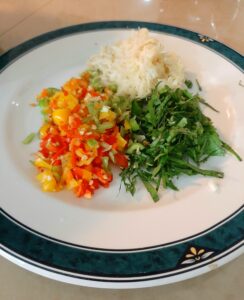
Measure out the salt.
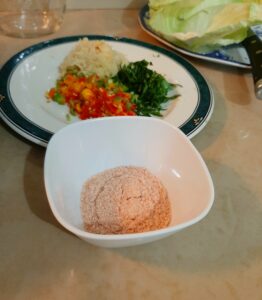
In a large container, add the chopped cabbage, seasonings and salt.
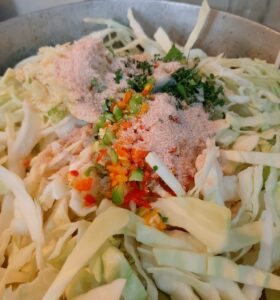
With clean hands, mix all the ingredients together while squeezing and massaging the salt into the cabbage for about 3 minutes. While doing this you want to crush or bruise the pieces of cabbage with your hands to break the cell walls and allow the natural water within to help create a brine. Next, cover it and allow it to rest for about half an hour.
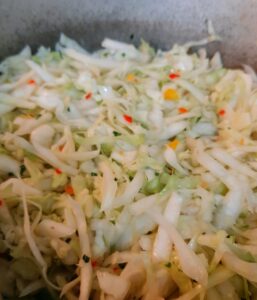
After allowing it to rest, transfer it to a mason or other glass jar and press it down into the jar. Include any liquid that was at the bottom of the mixing container. The brine will rise to the top. Ensure that the solids are fully submerged in the brine.
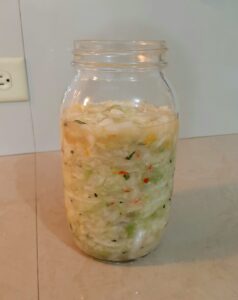
Put the clean reserved cabbage leaves on the top; push them into the brine.
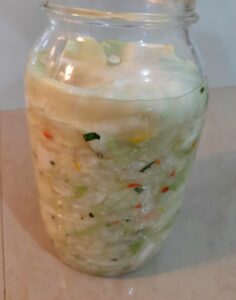
Next, use a weight to ensure that everything is well-submerged.
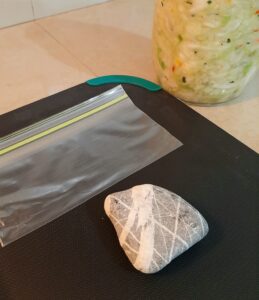
I didn’t have a fermentation weight so I improvised using a clean sanitized river rock in a sealed Ziploc bag.
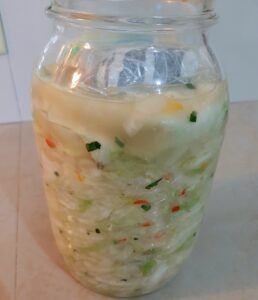
Leave at least 2 inches of head space between the brine and the lid and cover the jar loosely. Put the jar in a container should any of the fermenting brine bubble out. As the carbon dioxide is created during fermentation, bubbles can raise the sauerkraut to the top of the jar.
Store in an area away from direct light and heat, I like to put it in the kitchen cupboard.
Check on it every day. Ensure that the cabbage is submerged under the brine and open the lid to ‘burp’ it once a day to release some of the pressure created by the gas. Replace the lid on it immediately. If you need to use a utensil to push down the sauerkraut to re-submerge it, it is preferable to use a wooden or silicone spoon, avoid using metal.
Taste the sauerkraut as it ferments to find the flavour that you like as it becomes more sour the longer it ferments. I usually start tasting it after 3 days of fermentation. As the temperatures in everyone’s homes vary, fermentation may happen at different rates. For some, day 5 ferment may be the sweet spot, whereas, for others, day 12 might be best.
Once the flavour is where you like it, remove the weight and the cabbage leaves from the top of the sauerkraut, replace the lid and put it in the refrigerator. Fermentation slows down once placed in the fridge.
Sauerkraut kept in the fridge can last from 4 to 6 months. It usually finishes in my home long before that, as we love sauerkraut!
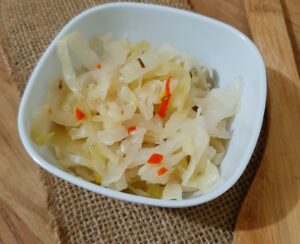
Since my journey into the world of homemade fermented foods, I have since made fermented garlic, cucumbers, carailie, sweet peppers and even fermented pepper sauce. It is a great way to preserve food especially when it is seasonally in abundance and at lower prices in the market. Not to mention all the valuable health benefits.
All-in-all I believe fermenting food at home is a valuable skill to have.
Homemade Sauerkraut
Equipment
- Cutting Board
- Container for leaves
- Knife
- Kitchen Scale
- Large container to mix cabbage
- Large Mason or Glass Jar
- Fermentation Weights or marbles or stones
Ingredients
- 3 lbs Cabbage
- 6 tsp Mineral Salt
- 5 large leaves Shadon Beni (Culantro)
- 1 head Garlic
- 4 whole Pimento Peppers
Instructions
- Remove the outer leaves of the cabbage. Rinse them thoroughly under running water and set them aside to drain for use later on.
- Prepare the cabbage by slicing or shredding. Discard the core (or put it in your next batch of bone broth.)
- Chop or mince the pimentoes and chadon beni. Finely grate the garlic or chop all the seasonings in a food processor.
- Measure out the salt.
- In a large container, add the chopped cabbage, seasonings and salt.
- With clean hands, mix all the ingredients together while squeezing and massaging the salt into the cabbage for about 3 minutes. While doing this you want to crush or bruise the pieces of cabbage with your hands to break the cell walls and allow the natural water within it to help create a brine. Next, cover it and allow it to rest for about half an hour.
- After the rest period, transfer to a mason or other glass jar and press it down into the jar. Be sure to include any liquid that was at the bottom of the mixing container. The brine will rise to the top. Ensure that the solids are fully submerged in the brine.
- Put the clean reserved cabbage leaves on the top; push them into the brine.
- Next, use a weight to ensure that everything is well-submerged. Leave at least 2 inches of head space between the brine and the cover and cover the jar loosely. Put the jar in a container in case any of the fermenting brine should bubble out.
- Store in an area away from direct light and heat.
- Check on it every day. Ensure that the cabbage is submerged under the brine and open the lid to 'burp' it once a day to release some of the pressure created by the gas. Replace the cover on it immediately. If you need to use a utensil to push down the sauerkraut to re-submerge it, it is preferable to use a wooden or silicone spoon.
- Taste it after 3 days of fermentation to find the flavour that you like as it becomes more sour the longer it ferments.
- Once the flavour is where you want it, remove the weight and the cabbage leaves from the top of the sauerkraut, replace the lid and put it in the refrigerator. Fermentation slows down once placed in the fridge. Sauerkraut kept in the fridge can last from 4 to 6 months.
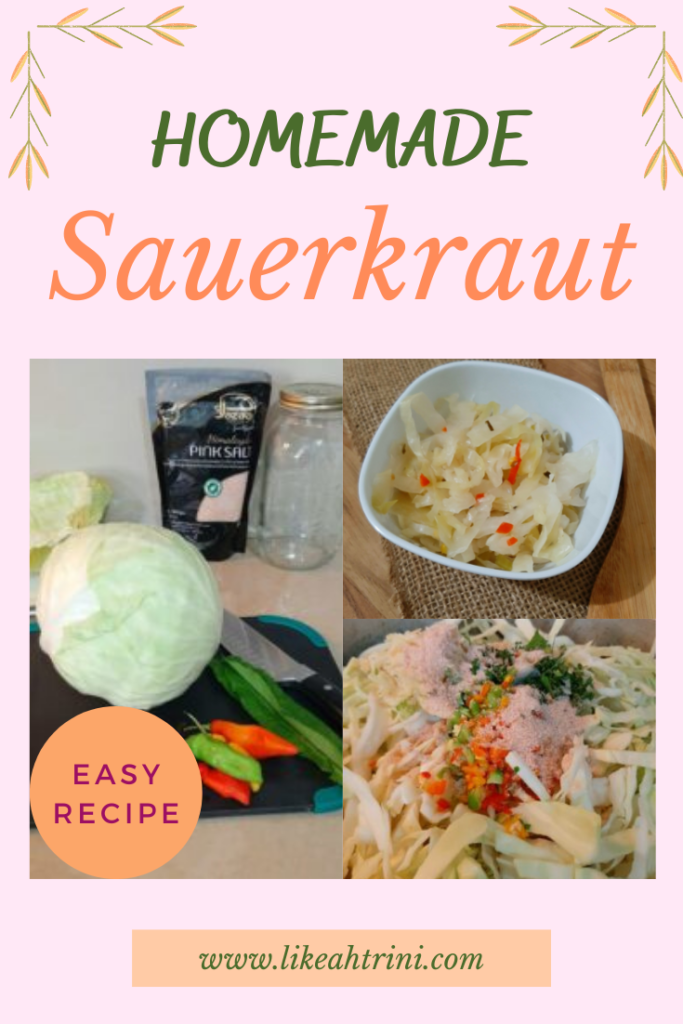
The post Homemade Sauerkraut – Fermented Cabbage appeared first on Like Ah Trini.
]]>The post Homemade Bone Broth appeared first on Like Ah Trini.
]]>Bone broth has been consumed in many cultures across the globe for centuries. In Traditional Chinese Medicine it is believed to improve sleep, help with digestive issues, heal the gut and also have anti-inflammatory properties.
In her book, New York Times Bestseller, Dr. Kellyann’s Bone Broth Diet, Kellyann Petrucci states that, “Bone broth isn’t just broth. And it isn’t just soup. It’s concentrated healing. This broth made from meat, poultry, or fish bones and simmered on the stove for hours until it turns into nutrient-rich ‘liquid gold,’ is one of the world’s oldest and most powerful medicinal foods.” Through her program, she has helped people lose weight and regain energy by adding broth to their daily nutrition.
The base for any bone broth is essentially bones, water and vinegar. Vegetables, herbs and spices are added for additional nutrition and flavour.
This can be a frugal way to use up bones leftover from previous meals and excess vegetables can be included as well. Chicken feet, back and neck, pig feet, turkey, lamb, and even fish bones can make a hearty broth. I personally prefer chicken feet, beef bones or cow heels when I make bone broth.
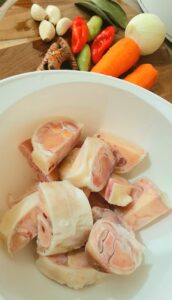
For this recipe, I used cow heel or cow foot as it is called in other parts of the Caribbean. It is a popular ingredient, especially in soups and it is widely available in supermarkets across the nation. Cow heel is rich in cartilage which breaks down to gelatin and amino acids when cooked. Apple cider vinegar is also added to the cooking process to dissolve valuable minerals in the bones.
Fresh turmeric root (Haldi) was included in my recipe for added benefits but you can add the powder or leave it out completely. Experiment with different spices and herbs and make it your own.

It is best to cook the broth low and slow. Some people cook it for between 24 and 48 hours.
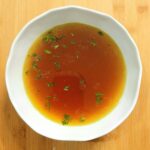
Caribbean Cow Heel Bone Broth
Equipment
- Slow Cooker (4 quarts or larger)
Ingredients
- 3 lbs Cow Heel
- 10 cups Water
- 2 medium Carrots
- 1 large Onion
- 2 tbsp Apple Cider Vinegar
- 4 whole Pimento Peppers
- 4 cloves Garlic
- 2 tbsp Turmeric Root
- 1 tbsp Cilantro
- 1 tbsp Chives
- 1 sprig Oregano
- 2 dried Bay Leaves
- 1 tsp Salt or to taste
- 1 dash Black Pepper or to taste
Instructions
- Add the cow heel to the slow cooker.
- Roughly chop the carrots, onion, pimento peppers, garlic, turmeric root, chives and cilantro. Add to the slow cooker.
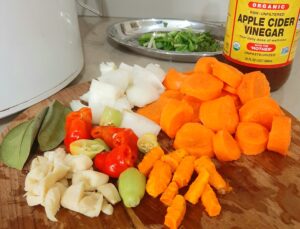
- Add the water, bay leaves, sprig of oregano, apple cider vinegar, salt and black pepper.
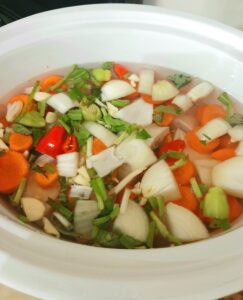
- Cover the slow cooker and allow the bones to simmer for at least 14 hours.
- When cooking is finished, adjust for salt then carefully strain the broth through a mesh strainer to remove the solids.
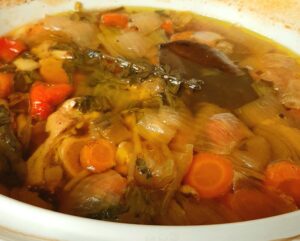
- Pour into a bowl or mug and enjoy immediately or allow it to cool fully before storing in the refrigerator for up to 4 days or up to 2 months in the freezer.
- Note that when the broth is chilled, it becomes gelatinous due to the collagen. The fat sits at the top and can be easily removed, if you prefer.
- Other than enjoying this broth on its own, it can be added to soups, sauces, stews and gravies.

The post Homemade Bone Broth appeared first on Like Ah Trini.
]]>The post My Favourite Caribbean Cookbooks appeared first on Like Ah Trini.
]]>From pelau to dhal puri, fried rice, buljol, oildown and everything in between, I absolutely love the traditional foods of my twin island home – a fusion of cultures that has evolved to create a gustatory experience that is all our own.
Back in the day, I used to enjoy going to the Chaguanas market on a weekend with my Mum to purchase fresh fruits, vegetables, provision, meat and fish. Then we would come home to grind up fresh green seasoning for the week and make some hot pepper sauce on the side. What we did not buy at the market we had growing in our kitchen garden in the back yard. Not to mention, that when times were lean, we could always count on the abundance of dasheen (taro) and dasheen bush that grew in the yard. Food in its pure, organic state, straight from nature’s bounty. The things we take for granted, eh!
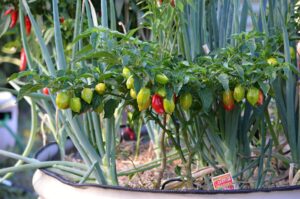
I have a great appreciation for the times in which we live now where we have access to online video tutorials that show exactly how the food is prepared and the different styles and methods of preparation.
Some of my personal favourites are Trini Cooking with Natasha, Caribbean Pot with Chris De la Rosa, Foodie Nation – especially Uncle Clyde from Paramin and Ms. Shanty.
I have to give credit to Natasha for teaching me how to make sada roti. (Once upon a time you would have thought I was trying to make homemade Crix.)
Over the years, I’ve collected many recipes and recipe books, some of which I’ve since passed on to family members but there are a few favourites that have been on my culinary bookshelf that are near and dear to me. Here are the books that have been valuable in helping me cook authentic Trinbagonian meals as well as dishes from other islands in the Caribbean and the world.
The Multi-Cultural Cuisine of Trinidad and Tobago & The Caribbean – Naparima Girls’ High School Cookbook
The Naparima Girls’ Cookbook has to be the most popular recipe book in Trinidad and Tobago, a household staple. For many years I had the original pink and white 1988 edition before I purchased my copy of the 2002 second edition.
The variety of dishes in this book is excellent! Chinese, Indian, Creole, Middle Eastern, cuisines of other countries and almost every snack and delicacy related to the many religious and cultural holidays we have here in sweet T&T.
I particularly love the Christmas recipes such as Pastelle, Trinidad Black Cake, Ginger Beer, Ponche de Creme, Sorrel Drink, and even homemade Chow Chow.
The second edition, containing over 500 recipes, is well-organized and has nutrition information, calories per serving, etc. which I always appreciate in a cookbook.
This is one book that I will definitely save to pass on to my children.
Curry, Callaloo and Calypso – Wendy Rahamut
I used to look forward to watching Wendy Rahamut on Caribbean Flavours, back in the day. I admired how she would ‘incorporate’ the ingredients and I learned different kitchen techniques from her. Although I have her other cookbook, Quick Fixin’ Recipes, I have a preference for Curry, Callaloo & Calypso – The Real Taste of Trinidad and Tobago.
Almost every Trinbagonian dish that could be listed off the top of your head, there is a recipe on how to prepare it. It has a good mix of Indian and Creole dishes, Soups, Beverages and a wide array of delicacies. Toolum, tamarind balls, barfi, coconut ice cream – those were the real treats in my childhood – all these are featured as well.
I think that this book is good for a novice cook or even a bachelor trying his hand at cooking. Simple recipes such as fried plantain, cheese paste sandwiches or even macaroni pie remove much of the intimidation with straightforward ingredients and easy-to-follow directions.
The quality of the photography and information in the book is fabulous, in my opinion.
An Adventure in Caribbean Cuisine – Caribbean Association of Home Economists
This is a gem of a cookbook particularly if you enjoy trying new recipes. The dishes showcase the medley of flavours that make up the kaleidoscope of Caribbean cuisine. From Anguilla to Jamaica, Trinidad and Tobago, and St Vincent and the Grenadines, here are some of the offerings:
- Farine pie – Guyana
- Pickled Breadnut – St. Lucia
- Bul Jol – Trinidad and Tobago
- Nasi Goreng – Suriname
- Ackee and Saltfish – Jamaica
One of my favourite aspects of this book is that nutrition information is included with each recipe detailing the number of servings, calories per recipe and per serving as well as macronutrient content – protein, carbohydrates, fats etc.
In part 2 of the book, there is a section on ‘Flavour aids’, which serves to educate the home cook on the uses and benefits of herbs and spices such as Allspice, Bayleaf, Clove, Garlic, Nutmeg etc as well as the exotic fruits and vegetables of the Caribbean.
Caribbean Food Made Easy with Levi Roots
Jamaican-born Levi Roots shares his love of cooking, inspired by his beloved grandmother, in his brilliant cookbook, Caribbean Food Made Easy.
Through his recipes, he encourages you to, “Seek out the wonderful foods and flavours of the Caribbean and explore the islands from your kitchen!”
Some of my favourite recipes from his book are, Sweet Lime and Angostura Bitters Chicken Bits, Saucy Plantain, Tamarind and Molasses Roast Chicken, Spicy Mackerel with Green Bananas and Caribbean Porridge.
This book features the following sections:
- One Pot and Suppers
- Fish and Seafood
- Roasts and Grills
- On the Side
- Beach and Street Food
- Desserts and Drinks
- Stocks.
Celebrate Food! – Naparima Girls’ High School Centenary Cookbook 1912-2012
“Cooking is like love – it should be entered into with abandon or not at all.”~ Harriet Van Horne
Celebrate Food! was created to commemorate the 100th Anniversary of the Naparima Girls’ High school. The recipes in this book are meant to encourage readers to try more ‘exotic dishes’.
Some of the more common local dishes in this cookbook are Pepper Roti, Stewed Red Beans, Curry Stew Chicken, Pineapple Mango Chow, and ‘Limers’ Corn Soup with Dumplings. There are also many recipes that are not typically Caribbean such as Greek Salad, Jerk Chicken Enchiladas, Moroccan Lamb Skewers with Tahini Yogurt and Sushi.
The editors of the book explain that “‘Celebrate Food!’ is an exploration of world cuisine and fusion cooking that showcases recipes that are not only culturally diverse but many of which are quick and easy to prepare.”
Recipes are categorized into:
- Appealing Appetizers
- Exciting Entrees
- Scrumptious Sides
- Delectable Desserts
- Blissful Beverages
The book has beautiful photography, information on preparation and cook times as well as a section on herbs, spices and napkin folds. I definitely recommend this book especially to experiment with cuisines outside of our region.
Feel free to share, what cookbooks are your favourite?
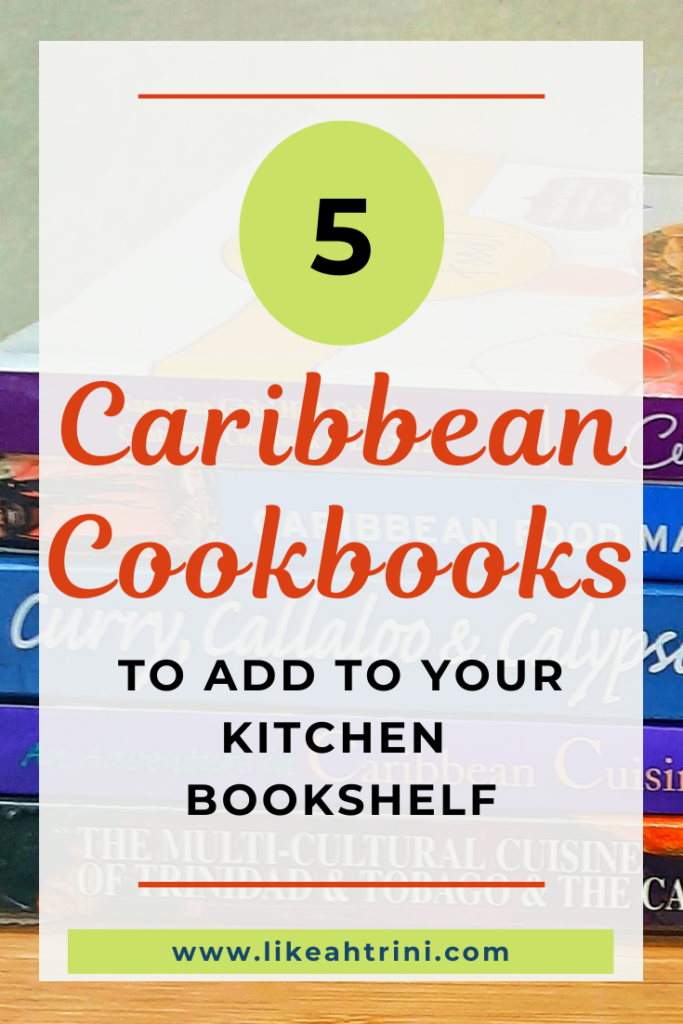
The post My Favourite Caribbean Cookbooks appeared first on Like Ah Trini.
]]>


